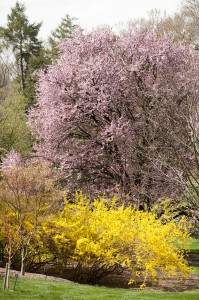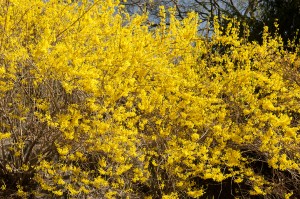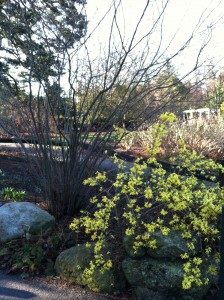Resurrecting Forsythia’s Reputation
Posted in Gardening Tips on April 23 2013, by Sonia Uyterhoeven
 Forsythias have a bad reputation for good reason. They are ubiquitous and weedy and we bemoan them while simultaneously populating urban and suburban landscapes with them. Forsythia is far too easy and that is a recipe for horticultural disaster in terms of abuse and overuse. It’s a sad story for a shrub with potential but there it is.
Forsythias have a bad reputation for good reason. They are ubiquitous and weedy and we bemoan them while simultaneously populating urban and suburban landscapes with them. Forsythia is far too easy and that is a recipe for horticultural disaster in terms of abuse and overuse. It’s a sad story for a shrub with potential but there it is.
We all know forsythia with its dependable bright yellow flowers in spring. It’s an easy shrub to grow, tolerating a wide range of conditions and is free from pests and diseases. Forsythia flowers best in full sun but tolerates part shade, is fast growing and easy to propagate from cuttings.
Forsythia is indigenous to eastern Asia. While it is hard to distinguish different species–it seems like there is one generic mass market version –different species and varieties do exist.
The forsythia that we generally see growing in gardens and municipal landscapes is Forsythia x intermedia. F. x intermedia is a cross between Forsythia suspensa, which has a nice arching habit, and Forsythia viridissima, which is more upright. It combines the two habits and has larger flowers than either, and more of them.
 There are a number of cultivated varieties that are popular in the trade. ‘Spectabilis’ has been around since 1906 and sets the standard for prolific flowering and vigorous growth. ‘Lynwood’ and ‘Karl Sax’ also have noteworthy flowers, and ‘Fiesta’ has variegated foliage.
There are a number of cultivated varieties that are popular in the trade. ‘Spectabilis’ has been around since 1906 and sets the standard for prolific flowering and vigorous growth. ‘Lynwood’ and ‘Karl Sax’ also have noteworthy flowers, and ‘Fiesta’ has variegated foliage.
The forsythia that is helping resurrect this shrub’s reputation in my eyes is a lovely compact variety called ‘Arnold Dwarf’. You can see it growing under a spice bush (Lindera benzoin) in the Home Gardening Center. This dwarf variety has a nice, open, sprawling habit and grows to be about 3 feet tall and wide. It is perfect for brightening up a corner of your garden without overwhelming everything around it. By virtue of its small size ‘Arnold Dwarf’ successfully redresses two major problems that plague most forsythia: the propensity for incorrect pruning and its fate as a one season wonder.
Forsythia can be prodigious in size, growing to 10 feet tall and almost as wide. Many homeowners hack at their forsythia in an effort to control them, shaping them into floral meatballs, when the best way to prune them is to maintain the integrity of the plant’s individual form. Prune up to 1/3 of the oldest growth in spring, removing any crossing or congested branches. Cut the oldest branches down to the base.

Pruning can be done before or after flowering. Pruning before flowering allows you to see the full structure of the shrub early in the season before the leaves open up, making it is easier to determine your cuts. The drawback to early pruning is loss of flowering branches, which is easily remedied by bringing a few of those branches inside to force. Pruning after flowering creates a less significant sacrifice of bloom, but makes it harder to see what you are doing.
Forsythia is considered by many a one season wonder: It looks fantastic in early April, but for the rest of the season looks drab and sits like an unbecoming messy green blob. ‘Arnold Dwarf’s cascading habit morphs into a pleasant arching form that doesn’t devour the space around it. It tucks into small spaces under larger shrubs or understory trees and is easy to under plant with woodland perennials.
When you visit the Garden Sculpture & Antiques Fair: 1750-2013, April 26, 27 and 28th, stop into the Home Gardening Center and take a look at this well-behaved dwarf forsythia. It’s a fresh look for an otherwise tired and overused shrub.

